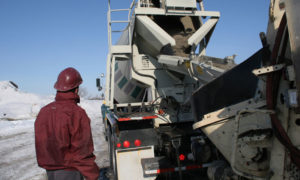Cold Weather Concreting
During Cold weather concreting, the rate of hardening and setting of concrete is very much retarded when the temperature falls below 21 deg. C. (70 deg. F.). At about 10 deg. C. (50 deg. F.) the action of setting slows down to about one-half of what it is at 21 deg. C. In addition to the slowing down or stopping of hydration and hardening there is also danger of disintegration of unset concrete due to the disruptive effect set up by the expansion of the mixing water as it freezes.
During cold weather concreting shall be abandoned when the temperature falls below 4.5 deg. C, (40 deg. F.). (Use immersion thermometer inserted in concrete near forms or surface for recording temperature.) however, the work is of urgency or importance that must be continued, it can be carried out with complete success provided certain remedial measures and precautions are taken.
The most convenient method is to heat the mixing water and, for very low temperatures to heat the aggregate as well. Heat the mixing water to 66 deg. C. (150 deg. F.). On no account shall the hot water be added to cement alone. Aggregates may be heated to 21 deg. C. Mixer drum may also be warmed. Cement must not be heated when used for cold weather concreting.
Temperatures of fresh concrete exceeding 21 deg. C. (70 deg. F.) are undesirable due to the higher water requirement, and likelihood of cracking when the concrete contracts on cooling, and relatively low strength. For most constructions, the right temperature of concrete at placement is somewhat below 21 deg. C. Concrete with a low water/cement ratio is less liable to damage by frost, and for good resistance to frost it is considered that the average water/cement ratio should not exceed 6.60 (30 litres per 50 kg of cement).
Fresh concrete must not be allowed to freeze. If concrete is frozen, setting and hardening ceases. Avoid the use of frozen aggregate. The concrete placed shall be protected against frost by suitable covering. Concrete damaged by frost shall be removed and work redone.
Provide layers of straw of other insulating material on the freshly laid concrete surface as soon as the concrete is hard enough to sustain it without detriment. An insulating layer for covering concrete may be composed of waterproof paper overlaid with a layer of straw and finally with second layer of waterproof paper.
In frosty or other adverse weather conditions, use of colloidal concrete may be considered,
An increase of cement content of the mix by about 20 to 25 per cent, use of rapid hardening cement with an admixture of calcium chloride or, high alumina cement are usually recommended. With high alumina Cement concreting can proceed without any further precautions provided that the temperature is not at freezing point or below and the materials are not frozen.
“Accelerators” are used in cold weather concreting to increase the rate of hardening and thereby reduce the likelihood of failure. They accelerate the hydration of the cement and increase the rate of evolution of heat ; thus the temperature of the concrete is raised and the freezing point of the mixing water is lowered, enabling concreting to be carried out when the air temperature is near or slightly below freezing point.
As far as practicable, the use of accelerators or admixtures should be avoided.
Calcium chloride is the most commonly used material for accelerating hardening of the concrete and is perhaps the most reliable, which may be used up to 2 per cent max : (prefer 1.5 per cent) of the weight of cement. Quantity in excess of this proportion is harmful.
In no circumstances should this chemical be added to high alumina cement. Calcium chloride is a white deliquescent and hygroscopic salt commercially available at low cost in flakes or granular form and delivered in moisture proof bags or airtight drums, and should be stored in a dry place. It is dissolved in the mixing water to which cement is added after wards. Calcium chloride should not be placed in contact with water or mixed dry with aggregate. Calcium chloride shall not be used where reinforcement is provided in the concrete.
The use of calcium chloride approximately halves the setting time; the concrete must be placed in position and finished with the minimum of delay because of the rapid setting.
Thanks for Visiting.
Cold weather concreting
See also Hot Weather Concreting
Related tags:
cost-effective design – concrete slabs and floors – concrete construction – building envelope – air entrainment – concrete curing – placing concrete in cold – concrete cold – cold concrete problems – cold concrete – concreting – cement – temperature – placing – repair – aggregates – hydration – freezing – moisture – placement.

